Shrimp and Sausage Gumbo
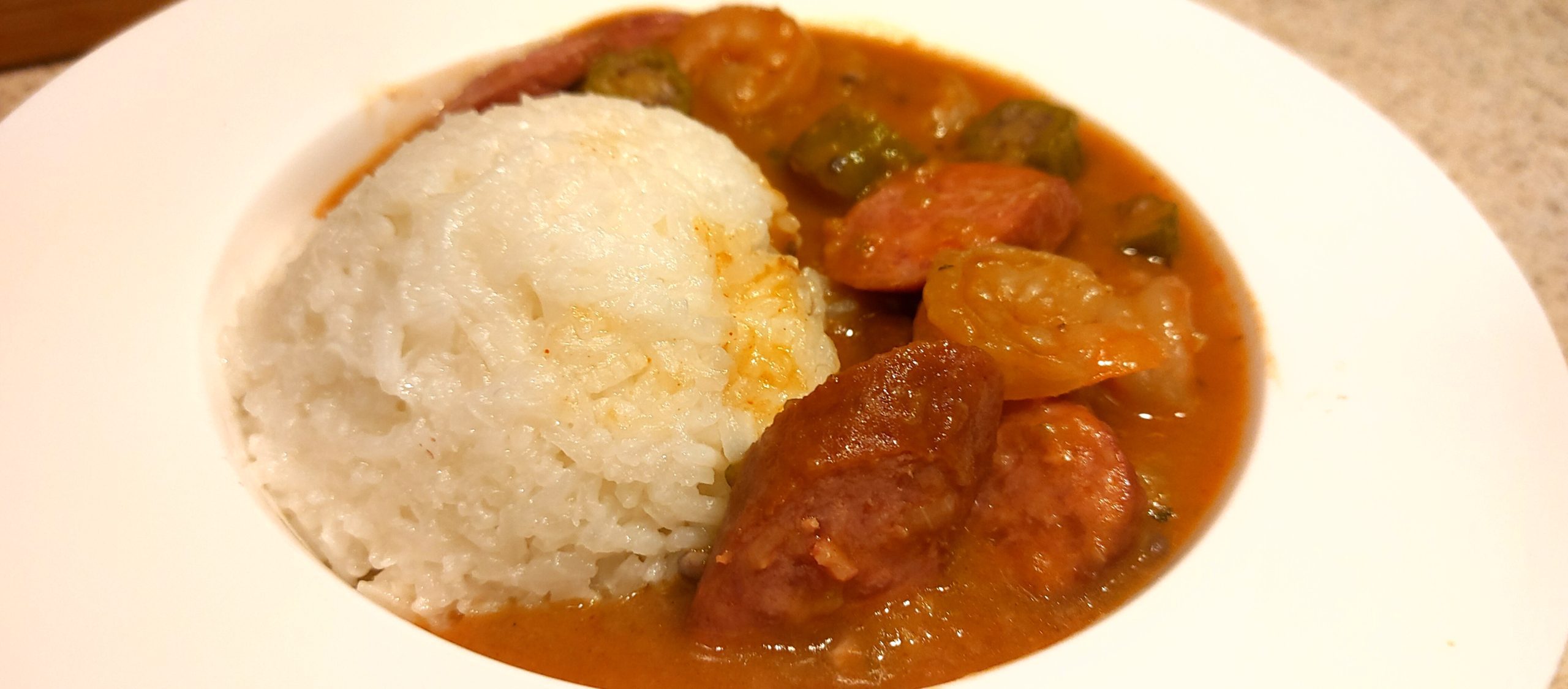
Step into the heart of Cajun cuisine with a culinary escapade that promises to warm your soul and tantalize your taste buds with Shrimp and Sausage Gumbo. This iconic Southern dish, rooted in the vibrant traditions of Louisiana, weaves a flavorful tapestry of plump shrimp, savory sausage, and a medley of aromatic spices, all harmonizing in a velvety roux-based broth. Join us on a flavorful expedition where each spoonful transports you to the bayous and bustling kitchens of the South, inviting you to savor the rich history and diverse flavors that make this Gumbo an everlasting gem in the realm of comfort food.
Where DID THIS LOUISIANA FAVORITE COME FROM?
Gumbo is a hearty and flavorful stew that originated in Louisiana, USA, with strong roots in West African, French, and Spanish culinary traditions. It is often considered a staple in Cajun and Creole cuisines. Gumbo is known for its rich and complex flavors, typically featuring a strong, well-seasoned broth, various proteins, and a variety of vegetables and spices.
The key components of gumbo include:
- Roux: A roux, made by cooking flour and fat (usually oil or butter) until it reaches a specific color ranging from light to dark brown, serves as the thickening agent for the gumbo. The roux also contributes a deep, nutty flavor to the dish.
- Proteins: Gumbo can include a variety of proteins, such as andouille sausage, chicken, shrimp, crab, or even game meats like rabbit or duck. The combination of proteins can vary based on regional and personal preferences.
- Vegetables: The “Holy Trinity” of Cajun and Creole cooking—onions, bell peppers, and celery—is often a fundamental part of gumbo. Other vegetables like okra and tomatoes are commonly used, contributing both flavor and texture to the stew.
- Broth: The base of the gumbo is typically a well-seasoned broth, often made with chicken or seafood stock. The broth is infused with a variety of herbs and spices, including thyme, oregano, bay leaves, and cayenne pepper.
- Seasonings: Cajun and Creole seasonings, such as paprika, garlic powder, onion powder, and cayenne pepper, play a crucial role in giving gumbo its distinct and bold flavor profile.
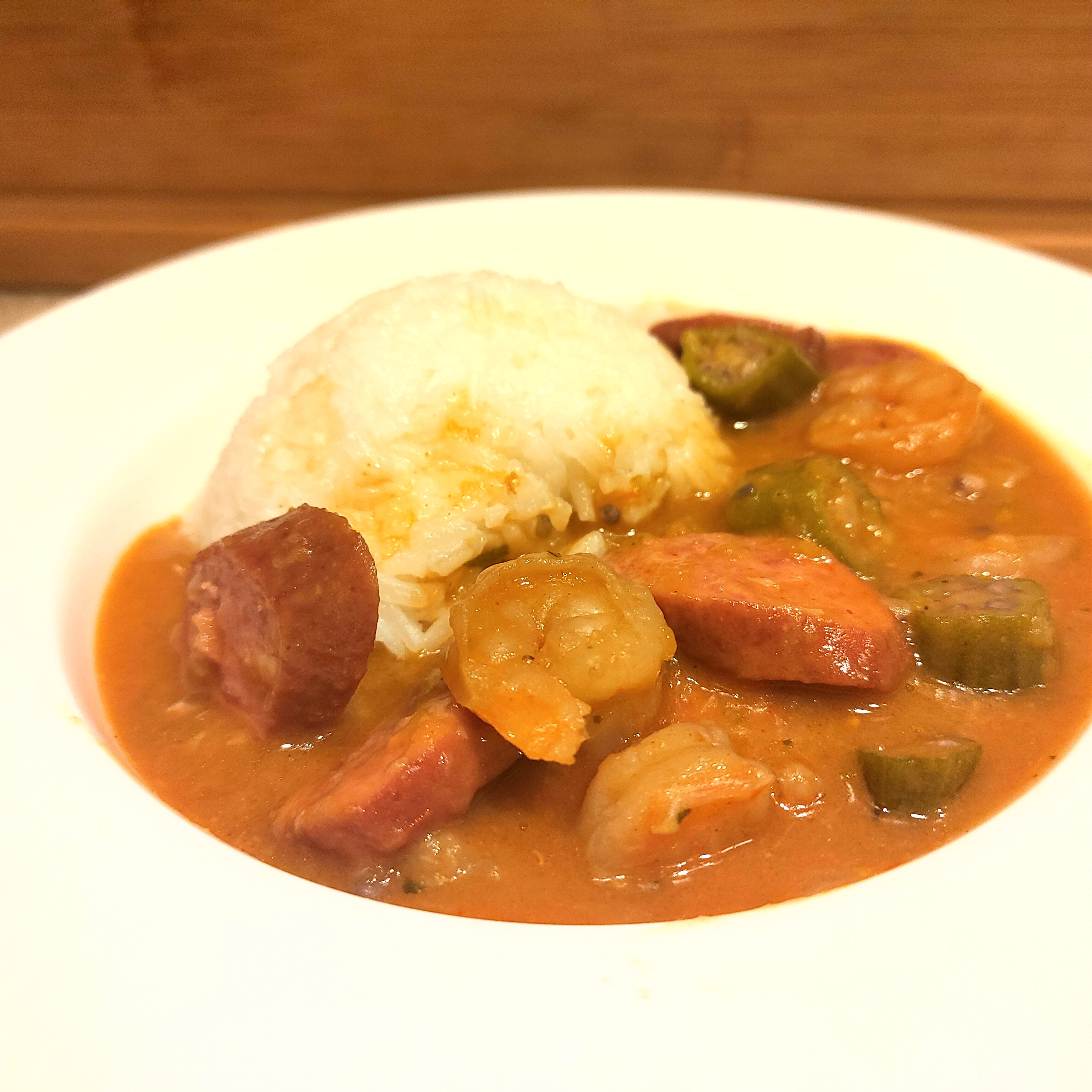
STAR-STUDDED INGREDIENTS NEEDED TO MAKE IT:
With these ingredients, you’re poised to create a Gumbo that pays homage to the rich culinary heritage of Louisiana. Get ready to savor the warmth and depth of this iconic Southern dish!
- 1 lb Shrimp:
- Plump and succulent, these shrimp add an essence to the gumbo, soaking up the rich flavors of the broth.
- 2 Links Andouille Sausage (Fresh, sliced at an angle):
- Sliced at a distinctive angle, fresh Andouille infuses the gumbo with smoky and spiced notes.
- 1/4 cup Vegetable Oil:
- The base for the roux, vegetable oil imparts a neutral flavor and works in harmony with the flour to create a velvety, golden-brown foundation.
- 3 tbsp Butter:
- Adding a touch of richness, butter elevates the roux, providing depth and enhancing the lusciousness of the gumbo.
- 1/2 Cup Flour:
- A key component in creating the roux, flour lends thickness and a nutty flavor that defines the gumbo’s signature consistency.
- 2 Stalks Celery (diced):
- Diced celery contributes a refreshing crunch and subtle herbal notes.
- 1 Bay Leaf:
- This aromatic leaf imparts a gentle herbal essence, infusing the gumbo with a layer of depth and fragrance.
- 1 Green Pepper (diced):
- Diced green pepper adds mild heat and vibrant color.
- 1 Yellow Onion (diced):
- Sweet and savory, diced yellow onion forms a flavorful foundation.
- 1/2 Cup Crushed Tomato:
- Offering a hint of acidity and sweetness.
- 1 tbsp Cajun Seasoning:
- A harmonious blend of spices, including paprika, garlic powder, and more, Cajun seasoning imparts an authentic and bold flavor profile.
- 4 Cups Chicken Stock:
- The soul of the gumbo, chicken stock forms a robust and savory base.
- 2 Cups Okra (chopped):
- Chopped okra not only thickens the gumbo but also adds a unique texture and subtle earthy flavor.
- 5 Cloves Garlic (minced):
- Minced garlic elevates the aromatic complexity, infusing the gumbo.
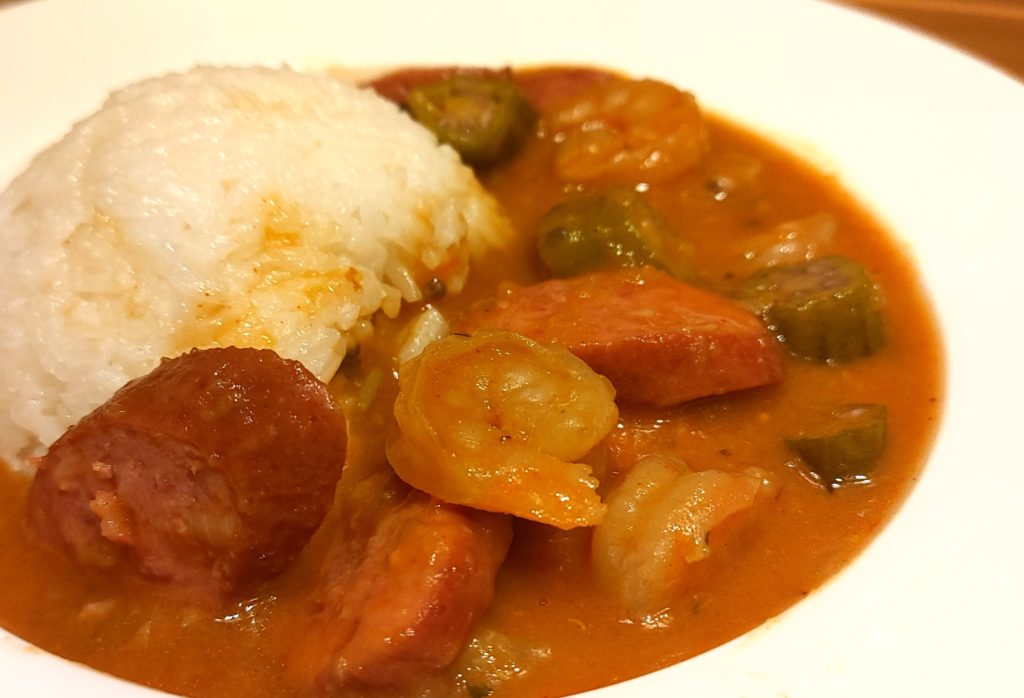
HOW TO MAKE IT?
Begin by preparing the roux. Heat oil and butter in a Dutch oven and add flour. Cook the flour while stirring constantly over medium heat for 20 minutes. It will gradually deepen in color to the color of peanut butter because it’s important to stir constantly so that the flour doesn’t stick to the bottom and burn.
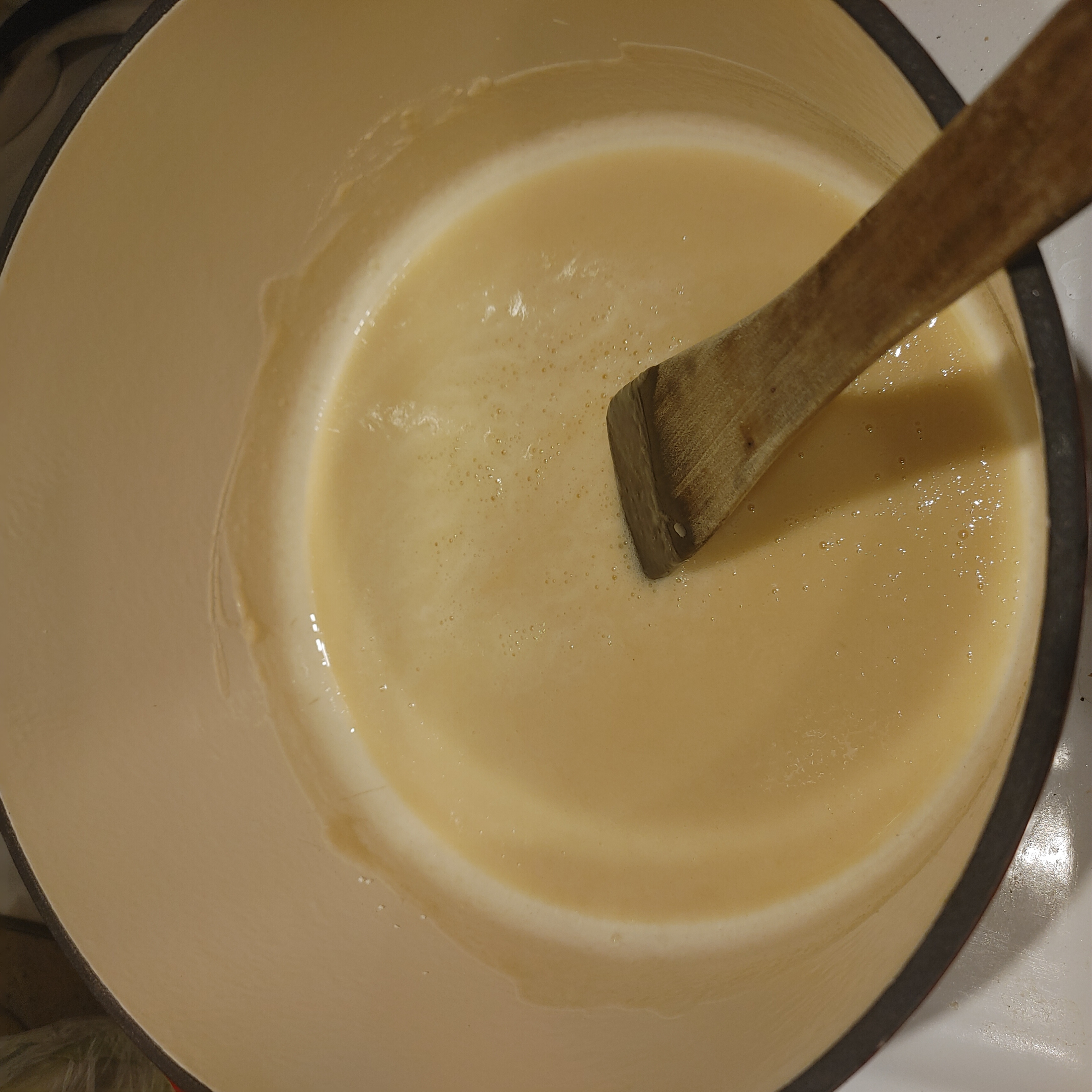
Once the roux has reached the desired color (peanut butter), add the bay leaf, onions, celery, and green peppers and stir for two to three minutes till the onions are tender. Finally, add the garlic and slowly add the chicken stock while stirring continuously until it thickens and comes to a boil.
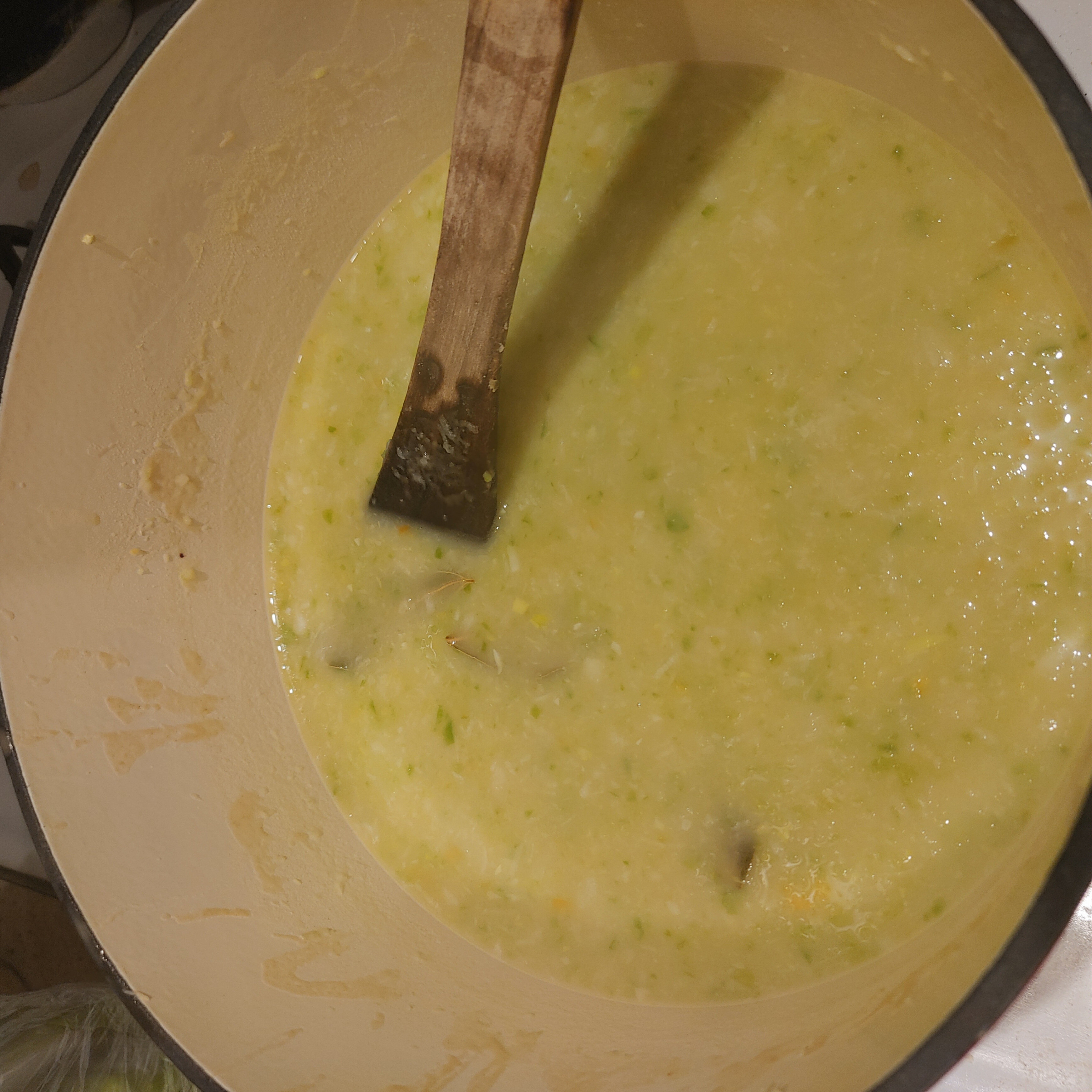
Stir in crushed tomatoes, cajun seasoning, and salt (if needed) along with the Audouille and okra. Mix well and bring this to a boil. Once the stew starts boiling, reduce the heat to low, cover, and let it simmer for 15 minutes or till the okra is cooked and not slimy.
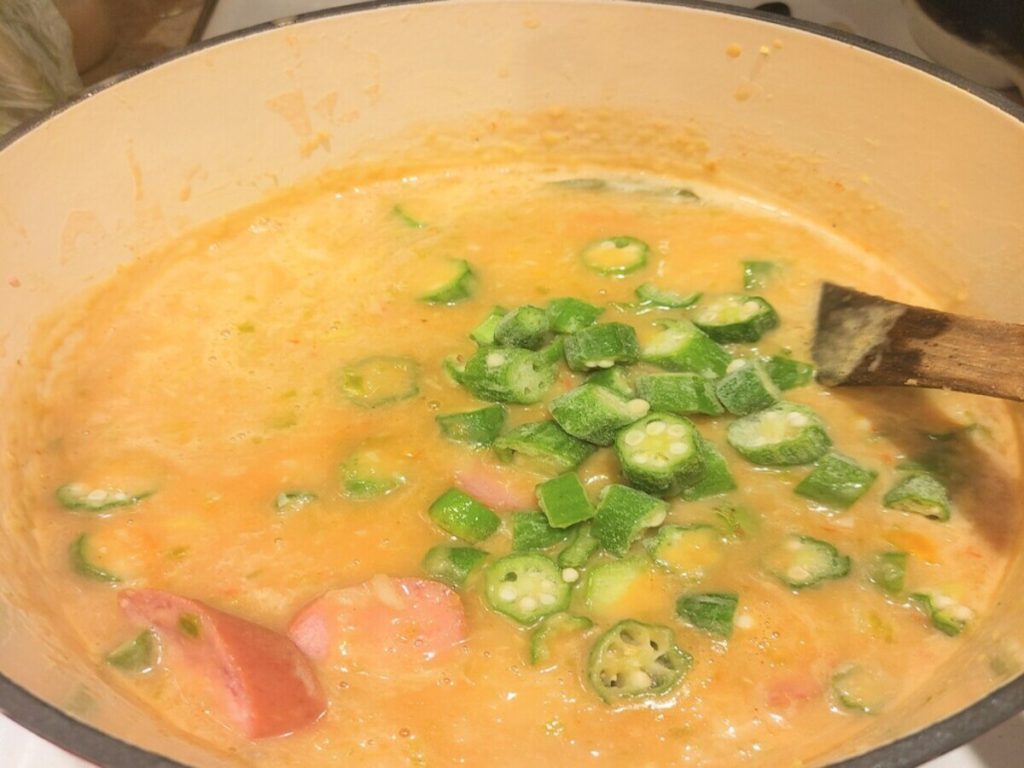
Add shrimp to the pot, simmer for an additional (8-10) minutes, and turn off the heat. What’s more gumbo tastes even better the next day as leftovers.
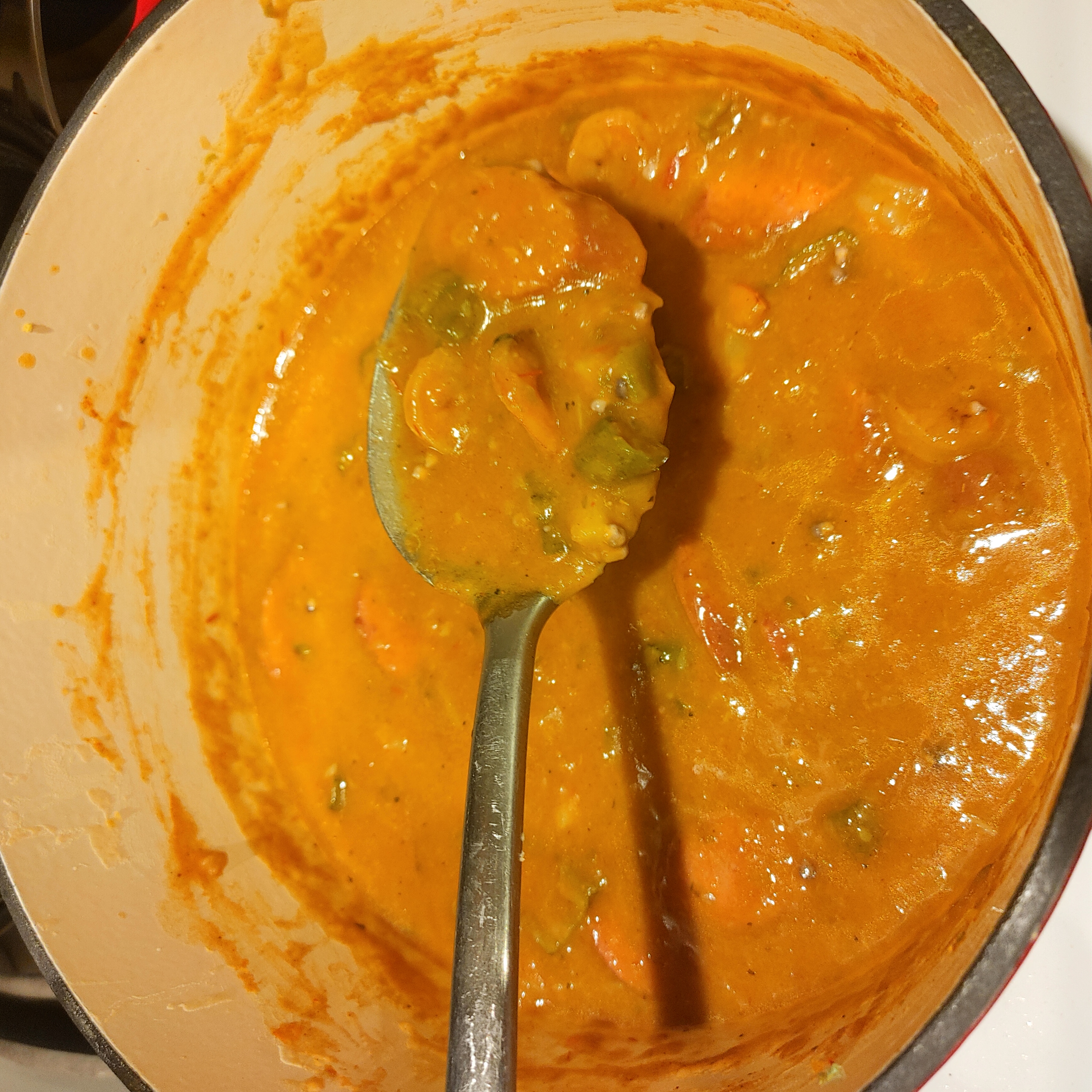
COMMON QUESTIONS AND PRO COOKING TIPS:
With these common questions and pro tips, you’ll be well on your way to mastering the art of cooking gumbo.
Common Questions:
- Can I use pre-cooked shrimp?
- Yes, you can. If using pre-cooked shrimp, add them towards the end of the cooking process to prevent overcooking and maintain their tenderness.
- What type of sausage works best for gumbo?
- Andouille is the traditional choice for gumbo, as it brings a smoky and spiced flavor that complements the dish. However, if Andouille is unavailable, smoked or another spicy sausage can be a good substitute.
- How do I prevent the roux from burning?
- Stir the roux constantly over medium heat and pay close attention to its color. Once it reaches a dark, rich brown, immediately add your vegetables to cool it down and stop the cooking process.
- Can I make gumbo in advance?
- Absolutely. Gumbo often tastes even better the next day as the flavors have had time to meld. Store it in the refrigerator and reheat gently on the stove.
Pro Cooking Tips:
- Sauté the Sausage First:
- Sauté the sliced sausage first before cooking the other ingredients. This step enhances the smoky flavor and allows some of the oils to be released, adding depth to the gumbo.
- Fresh vs. Frozen Shrimp:
- If using frozen shrimp, thaw them in the refrigerator before adding them to the gumbo. This ensures even cooking and prevents excess water from affecting the dish’s consistency.
- Homemade Cajun Seasoning:
- Consider making your own Cajun seasoning for a more personalized flavor. A blend of paprika, garlic powder, onion powder, thyme, oregano, and cayenne pepper can be adjusted to your taste preferences.
- Slow and Low for Flavor Development:
- Gumbo is a dish that benefits from slow, low-heat cooking. Allow it to simmer and develop its flavors over time. This will result in a richer and more complex dish.
- Use Fresh Ingredients:
- Whenever possible, use fresh ingredients, especially for vegetables and herbs. This enhances the overall vibrancy and freshness of the gumbo.
- Adjust Spices Gradually:
- Cajun seasoning can vary in intensity. Add it gradually, tasting as you go, to avoid over-seasoning. You can always add more later, but it’s challenging to fix an overly spicy dish.
- Serve with Rice or Bread:
- Gumbo pairs exceptionally well with rice or crusty bread. The starch helps absorb the flavorful broth and provides a satisfying texture contrast.
- Experiment with Garnishes:
- Garnish your gumbo with fresh herbs like chopped parsley or green onions just before serving. It adds a burst of color and a final layer of freshness.
HOW TO STORE AND REHEAT LEFTOVERS?
Leftover gumbo can be stored in the refrigerator for up to 3-4 days in an airtight container. Then gently reheat on the stovetop for best results or it can be placed in a microwave-safe dish and microwaved for 2 minutes on HIGH.
How to freeze GUMBO?
The key to preserving its rich flavors and textures for later enjoyment. Once you’ve prepared this savory Southern dish, follow these steps to ensure a seamless freezing process:
Cooling to Room Temperature: After preparing your gumbo, allow it to cool to room temperature. This crucial step prevents condensation inside the storage container and avoids the development of ice crystals.
Choosing the Right Storage Containers: Opt for airtight containers or heavy-duty freezer bags designed for long-term storage. Be sure to use containers specifically labeled as freezer-safe to prevent potential damage to the container and preserve the gumbo’s quality.
Leaving Room for Expansion: Leave some space at the top of the container or bag to accommodate for expansion during the freezing process. This precautionary measure prevents the container from cracking or the bag from bursting.
Labeling for Organization: Clearly label each container or bag with the date of preparation. This practice ensures that you keep track of how long the gumbo has been in the freezer.
Adhering to a Time Frame: Keep in mind the gumbo maintains its best quality for approximately 2-3 months in the freezer.
Safe Thawing and Reheating: When you’re ready to enjoy your frozen gumbo, transfer the container to the refrigerator and allow it to thaw overnight. Avoid thawing at room temperature to prevent bacterial growth. Reheat the thawed gumbo on the stove over medium-low heat, stirring occasionally, and ensure it reaches an internal temperature of 165°F (74°C) for safety.
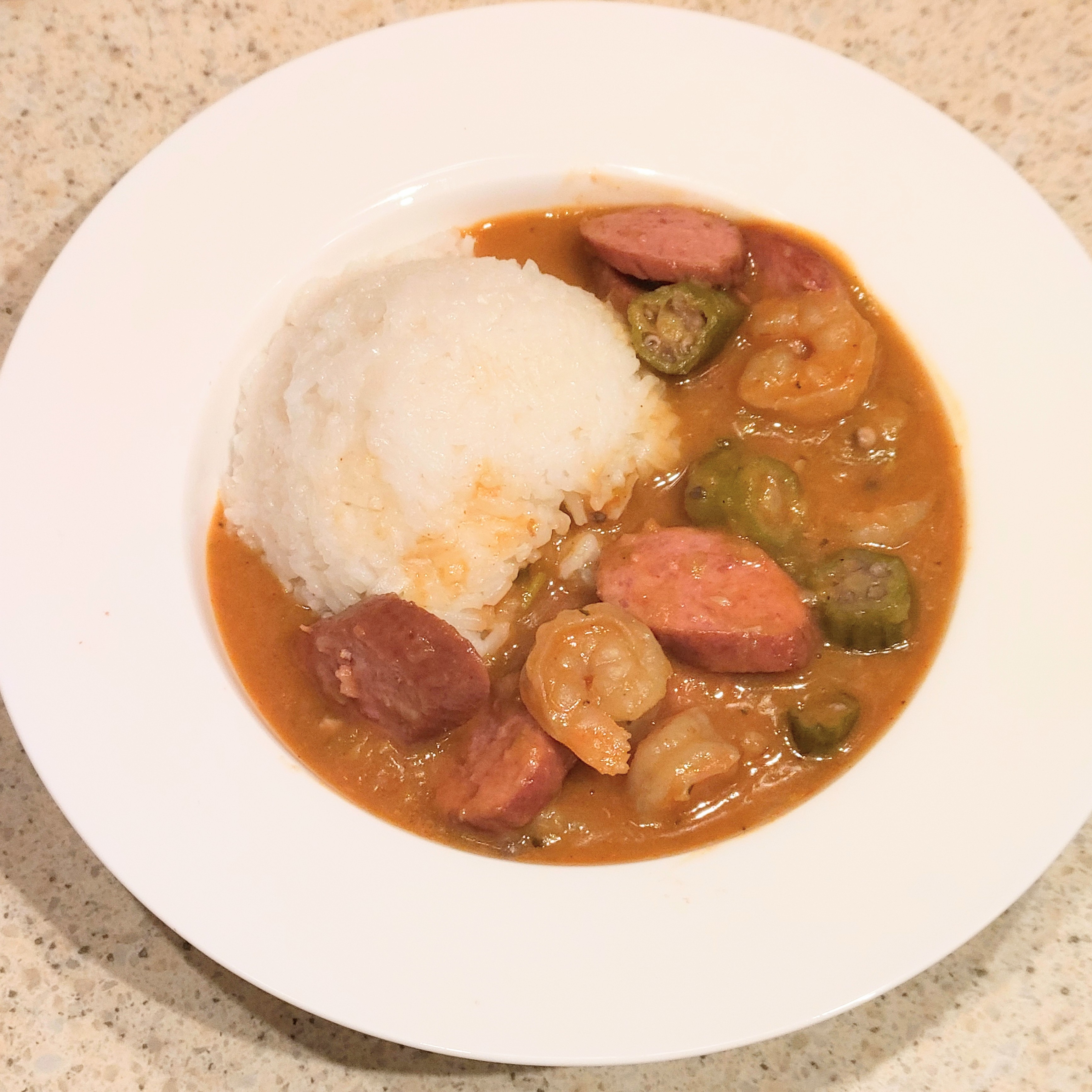
what is best served?
This gumbo is a hearty and flavorful dish that pairs well with various accompaniments. Here are some classic options that complement the rich flavors of gumbo:
- White Rice:
- The most traditional pairing, a bed of fluffy white rice is an excellent choice because rice provides a neutral base that allows the bold taste of the gumbo to shine.
- Cornbread:
- The slightly sweet and crumbly texture of cornbread is a wonderful contrast to the savory and spicy notes of the gumbo. It also adds a comforting element to the meal.
- Crusty French Bread:
- A loaf of crusty French bread is perfect for mopping up every last bit of the delicious gumbo sauce. The chewy texture and crispy crust enhance the dining experience.
- Collard Greens:
- The earthy and slightly bitter taste of collard greens contrasts nicely with the richness of the gumbo. Sautéed or steamed collard greens make for a tasty and nutritious side.
- Potato Salad:
- A cool and creamy potato salad can provide a refreshing contrast to the bold flavors of the gumbo. It adds a different texture and complements the warmth of the dish.
- Pickled Vegetables:
- Pickled vegetables, such as okra, green beans, or cucumbers, can provide a tangy and crunchy element that cuts through the richness of the gumbo.
- Coleslaw:
- A crisp and tangy coleslaw brings a refreshing crunch to the meal. Its lightness and acidity can balance out the heartiness of the gumbo.
- Simple Salad:
- A simple salad with cabbage, cucumber, and a light vinaigrette can offer a fresh and creamy side such as this Green Goddess Salad will offer a contrast to the bold flavors of the gumbo.
- Grilled or Steamed Vegetables:
- Lightly seasoned grilled or steamed vegetables, such as asparagus, broccoli, or green beans, can add a healthy and colorful component to the meal.
Shrimp and Sausage Gumbo
Equipment
- Large Dutch Oven
Ingredients
- 1 lb Shrimp
- 2 Links Andouille Sausage Fresh (sliced at an angle)
- 1/4 cup Vegetable oil
- 3 tbsp Butter
- 1/2 Cup Flour
- 2 Stalks Celery (diced)
- 1 Bay Leaf
- 1 Green Pepper (diced)
- 1 Yellow Onion (diced)
- 1/2 Cup Crushed Tomato
- 1 tbsp Cajun Seasoning
- 4 Cups Chicken Stock
- 2 Cups Okra (chopped)
- 5 Cloves Garlic (minced)
Instructions
- Begin by preparing the roux. Heat oil and butter in a dutch oven and add flour. Cook the flour while stirring constantly over medium heat for 20 minutes. It will gradually deepen in color to the color of peanut butter. It's important to stir constantly so that the flour doesn't stick to the bottom and burn.
- Once the roux has reached the desired color (peanut butter), add the bay leaf, onions, celery, and green peppers and stir for two to three minutes till the onions are tender. Add garlic and slowly start adding chicken stock while stirring continuously until it thickens and comes to a boil.
- Stir in crushed tomatoes, cajun seasoning, and salt (if needed) along with the fresh sausage and okra. Mix well and bring this to a boil. Once the stew starts boiling, reduce the heat to low and cover and let it simmer for 15 minutes or till the okra is cooked and not slimy.
- Add shrimp to the pot, simmer for an additional (8-10) minutes and turn off the heat. Gumbo tastes even better the next day as leftovers.
- Serve over rice

